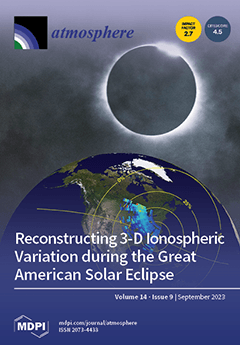In natural ventilation system-enabled dairy buildings (NVDB), achieving accurate gas emission values is highly complicated. The external weather affects measurements of the gas concentration of pollutants (
) and volume flow rate (
Q) due to the open-sided design. Previous
[...] Read more.
In natural ventilation system-enabled dairy buildings (NVDB), achieving accurate gas emission values is highly complicated. The external weather affects measurements of the gas concentration of pollutants (
) and volume flow rate (
Q) due to the open-sided design. Previous research shows that increasing the number of sensors at the side opening is not cost-effective. However, accurate measurements can be achieved with fewer sensors if an optimal sampling position is identified. Therefore, this study attempted to calibrate the outlet of an NVDB for the direct emission measurement method. Our objective was to investigate the
gradients, in particular, for ammonia (
), carbon dioxide (
), and methane (
) considering the wind speed (
v) and their mixing ratios ([
]) at the outlet, and assess the effect of sampling height (H). The deviations in each
at six vertical sampling points were recorded using a Fourier-transform infrared (FTIR) spectrometer. Additionally, wind direction and speed were recorded at the gable height (10 m) by an ultrasonic anemometer. The results indicated that, at varied heights, the average
(
p < 0.001),
(
p < 0.001), and (
p < 0.001) were significantly different and mostly concentrated at the top (H = 2.7). Wind flow speed information revealed drastic deviations in
, for example up to
higher
at the top (H = 2.7) compared to the baseline (H = 0.6), especially during low wind speed (
v < 3 m s
) events. Furthermore, [
] exhibited significant variation with height, demonstrating instability below 1.5 m, which aligns with the average height of a cow. In conclusion, the average
,
, and
measured at the barn’s outlet are spatially dispersed vertically which indicates a possibility of systematic error due to the sensor positioning effect. The outcomes of this study will be advantageous to locate a representative gas sampling position when measurements are limited to one constant height, for example using open-path lasers or low-cost devices.
Full article





